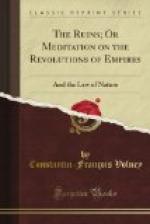The relative positions of the signs and constellations in the zodiac and ecliptic seem thus to have gradually changed with the revolving years; and the worship of the three constellations, Taurus, Aries, and Pisces, with which Christianity is so intimately connected, seems to have changed in a corresponding degree. The worship of the bull of Egypt—the celestial Taurus—has given place to that of the lamb of Palestine—the celestial Aries; and under the astronomical emblem Pisces—the twelfth sign of the zodiac—the dominant faith of to-day was appropriately taught by the twelve apostolic fishermen.
It is from one of these chosen fishermen, St. Peter, that the Pope of Rome claims to have derived his arbitrary power for binding and loosing on earth those who are to be bound and loosed in heaven. (Matt. xvi, 19.) The grave responsibility of wielding with justice and equity this tremendous power over the future destiny of mankind, seems never to have disconcerted any of the successors of St. Peter. They have all proved to be equally arrogant and intolerant, zealous for both temporal and spiritual domination, and merciless to those who have opposed their pretensions. The present incumbent of the papal chair, who modestly claims the attribute of infallibility, seems proud of his inherited title, The Great Fisherman! and hopes in the progress of time, with the assistance of his monks, bishops, and cardinals, to entangle all nations in his net of faith, and to dictate with unquestioned authority the religious worship of the entire human race.
As the precession of the equinoxes still continues as of yore, and as the masses still continue credulous and devout, they may in succeeding ages be again called upon to worship the god Apis, when the sign of Taurus shall again coincide in the zodiac and the ecliptic; and Aries, “the lamb of God,” may again be offered in the “fullness of time” as a sacrifice for mankind, again be crucified, and again shed his redeeming blood to wash away the sins of a believing world.
M. Dupuis has satisfactorily shown in The History of all Religions that the twelve labors of the god and saviour Hercules were astronomical allegories—the history of the passage of the sun through the twelve signs of the zodiac—and these labors are so similar to the sufferings of Jesus, that the Rev. Mr. Parkhurst has been obliged, much against his inclination, to acknowledge that they “were types of what the real Saviour was to do and suffer.” (Parkhurst, p.47.) An intimate connection, if not identity, is thus shown between ancient and modern belief—between the paganism of the past and the orthodoxy of the present.
THE ZODIACAL SIGNS.
Aries, the Ram: (marked [symbol for Aries])—A northern constellation, usually named as the first sign in the zodiac, into which, when the sun enters at the vernal equinox in March, the days and nights are of equal length. Aries has been regarded by the devout during many ages as the celestial representative, visible in the heavens, of “the Lamb of God that taketh away the sins of the world.”




